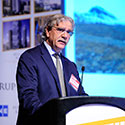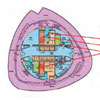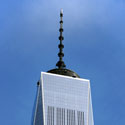Filter by
You must be a CTBUH Member to view this resource.
Jin Mao Tower
Jin Mao Building
Building
Completed, 1999
200121
hotel / office
composite
420.5 m / 1,380 ft
88
3
993
61
9 m/s
289,500 m² / 3,116,152 ft²
You must be a CTBUH Member to view this resource.
You must be a CTBUH Member to view this resource.
Usually involved in the front end design, with a "typical" condition being that of a leadership role through either Schematic Design or Design Development, and then a monitoring role through the CD and CA phases.
Usually takes on the balance of the architectural effort not executed by the "Design Architect," typically responsible for the construction documents, conforming to local codes, etc. May often be referred to as "Executive," "Associate," or "Local" Architect, however, for consistency CTBUH uses the term "Architect of Record" exclusively.
The Design Engineer is usually involved in the front end design, typically taking the leadership role in the Schematic Design and Design Development, and then a monitoring role through the CD and CA phases.
The Engineer of Record takes the balance of the engineering effort not executed by the “Design Engineer,” typically responsible for construction documents, conforming to local codes, etc.
The Design Engineer is usually involved in the front end design, typically taking the leadership role in the Schematic Design and Design Development, and then a monitoring role through the CD and CA phases.
The main contractor is the supervisory contractor of all construction work on a project, management of sub-contractors and vendors, etc. May be referred to as "Construction Manager," however, for consistency CTBUH uses the term "Main Contractor" exclusively.
Other Consultant refers to other organizations which provided significant consultation services for a building project (e.g. wind consultants, environmental consultants, fire and life safety consultants, etc).
These are firms that consult on the design of a building's façade. May often be referred to as "Cladding," "Envelope," "Exterior Wall," or "Curtain Wall" Consultant, however, for consistency CTBUH uses the term "Façade Consultant" exclusively.
Material Supplier refers to organizations which supplied significant systems/materials for a building project (e.g. elevator suppliers, facade suppliers, etc).
Other Consultant refers to other organizations which provided significant consultation services for a building project (e.g. wind consultants, environmental consultants, fire and life safety consultants, etc).
Material Supplier refers to organizations which supplied significant systems/materials for a building project (e.g. elevator suppliers, facade suppliers, etc).
You must be a CTBUH Member to view this resource.
Usually involved in the front end design, with a "typical" condition being that of a leadership role through either Schematic Design or Design Development, and then a monitoring role through the CD and CA phases.
Usually takes on the balance of the architectural effort not executed by the "Design Architect," typically responsible for the construction documents, conforming to local codes, etc. May often be referred to as "Executive," "Associate," or "Local" Architect, however, for consistency CTBUH uses the term "Architect of Record" exclusively.
The Design Engineer is usually involved in the front end design, typically taking the leadership role in the Schematic Design and Design Development, and then a monitoring role through the CD and CA phases.
The Engineer of Record takes the balance of the engineering effort not executed by the “Design Engineer,” typically responsible for construction documents, conforming to local codes, etc.
The Design Engineer is usually involved in the front end design, typically taking the leadership role in the Schematic Design and Design Development, and then a monitoring role through the CD and CA phases.
The main contractor is the supervisory contractor of all construction work on a project, management of sub-contractors and vendors, etc. May be referred to as "Construction Manager," however, for consistency CTBUH uses the term "Main Contractor" exclusively.
Other Consultant refers to other organizations which provided significant consultation services for a building project (e.g. wind consultants, environmental consultants, fire and life safety consultants, etc).
These are firms that consult on the design of a building's façade. May often be referred to as "Cladding," "Envelope," "Exterior Wall," or "Curtain Wall" Consultant, however, for consistency CTBUH uses the term "Façade Consultant" exclusively.
Material Supplier refers to organizations which supplied significant systems/materials for a building project (e.g. elevator suppliers, facade suppliers, etc).
Other Consultant refers to other organizations which provided significant consultation services for a building project (e.g. wind consultants, environmental consultants, fire and life safety consultants, etc).
Material Supplier refers to organizations which supplied significant systems/materials for a building project (e.g. elevator suppliers, facade suppliers, etc).
Performance Award 2014 Award of Excellence
2014 CTBUH Awards
2019 International Forum on Tall Buildings and Urban Habitat
28 August 2019 - Event
SuperTEC Visit to CTBUH China Office
17 January 2017 - Event

03 November 2016 | Shanghai
Innovations in Building Performance and Resiliency: Pin-Fuse Seismic Systems
Throughout history, it has been proven time and again that the simplest innovations can often offer the greatest and widest ranging impact. This is certainly...

28 October 2019
Fifty Years of Fire Safety In Supertall Buildings
Peter Weismantle, AS+GG; James Antell, Telgian Engineering & Consulting
As international design teams participated in the development of high-rise structures around the world, many of the concepts of fire-safe design first introduced in the...
The Jin Mao Tower, a mixed-use complex containing offices, convention space and a hotel and in 2013 became the tallest and the longest-operated building in China to receive a LEED-EB: OM (Existing Buildings: Operations + Management) Gold certification. Its high performance has been achieved with the assistance of a computerized energy management system, which has been in place since the building opened, and is integrated with the broader enterprise asset management (EAM) system.
Management tracks a variety of performance metrics, including electricity, water, and natural gas consumption from month to month, and maintains key performance indicators (KPIs) around non-energy metrics, such as preventative maintenance, fixed asset purchases, requests for repairs, complaints, cost analysis and equipment information records. The paperless processing associated with the system also contributes to the building’s low carbon-emission footprint. Beginning in August 2013, to promote indoor air quality (IAQ) the building’s managers began tracking PM 2.5 particulate values in office areas, and broadcasting the results daily on social media.
These performance measurement approaches have been augmented by consulting with the Association of German Engineers, which has helped Jin Mao develop computerized equipment management systems to help maintenance staff optimize the equipment life cycle, quality and cost. A fluid energy metering system measures the flow of water through 89 sensors distributed throughout the building. An electricity metering system remotely and automatically measures electricity consumption of large equipment through a network of 300 sensors, allowing comparison of current and historical energy consumption. Together, these systems provide an objective data foundation for energy-use analysis.
Each month, building managers hold an energy-consumption analysis meeting and clarify energy expenditure of each main equipment category, including water, electricity, and natural gas. The management team actively compares year-on-year and month-to-month consumption statistics, referencing the building automation system’s daily control log, to make informed decisions about where energy-saving strategies should be implemented next. Specific action items are then drawn up for specific people, who take charge of implementing these measures.
Performance Award 2014 Award of Excellence
2014 CTBUH Awards

03 November 2016 | Shanghai
Innovations in Building Performance and Resiliency: Pin-Fuse Seismic Systems
Throughout history, it has been proven time and again that the simplest innovations can often offer the greatest and widest ranging impact. This is certainly...

16 September 2014 | Shanghai
The Evolution of Building Evacuation Design in China
As a result of the events of September 11th and other natural and man-made disasters, building owners, designers and fire officials have become increasingly aware...

07 November 2013 | Shanghai
Fazlur Khan Lifetime Achievement Medal: Geotechnics for the World’s Tallest
Clyde Baker has performed geotechnical engineering for seven of the 16 tallest buildings in the world, and a major portion of the high-rise buildings built...
20 September 2012 | Shanghai
Interview: Constructing the Shanghai Tower
Jun Xia of Gensler is interviewed by Jeff Herzer during the 2012 CTBUH Shanghai Congress at the Jin Mao, Shanghai. Jun discusses the design and...

20 September 2012 | Shanghai
The Design Process of Complex Architectural Facades
Facades form the identity and functionality of high-rise buildings. The “design process” for complex bespoke architectural high-rise facades is an abstract term that in reality...

19 September 2012 | Shanghai
Development of Innovative Structures for Supertall and Unique Towers
As tall buildings grow to greater heights and strive to incorporate more unique forms, clarity in the development of the structural system at conceptual design...

19 September 2012 | Shanghai
From Jin Mao to Kingdom: Search for an Asian Supertall Vernacular
This presentation presents the evolution of Mr. Smith’s career as a designer of supertall buildings, from Shanghai’s Jin Mao Tower, completed in 1999, to Kingdom...

19 September 2012 | Shanghai
Gordon Gill of Adrian Smith + Gordon Gill Architecture is interviewed by Jeff Herzer during the 2012 CTBUH Shanghai Congress at the Jin Mao, Shanghai....

19 September 2012 | Shanghai
Adrian Smith of Adrian Smith + Gordon Gill Architecture is interviewed by Jeff Herzer during the 2012 CTBUH Shanghai Congress at the Jin Mao, Shanghai....

19 September 2012 | Shanghai
Interview: Marketing of Tall Buildings
William Murray of Wordsearch is interviewed by Jeff Herzer during the 2012 CTBUH Shanghai Congress at the Jin Mao, Shanghai. William discusses the marketing of...

28 October 2019
Fifty Years of Fire Safety In Supertall Buildings
As international design teams participated in the development of high-rise structures around the world, many of the concepts of fire-safe design first introduced in the...
AirPanoPAID_EDIT.jpg)
17 October 2016
SOM and China: Evolving Skyscraper Design Amid Rapid Urban Growth
China’s rapid urban and economic growth has challenged designers, engineers, and planners to innovate and collaborate to meet the needs of a changing country. Skidmore,...

26 October 2015
Context, Climate, Culture – Investigating Place in Tall Building Design
Should a tower in Moscow look like one in Dubai? Once one entered a city and marveled at the unique magic of its architecture –...

16 September 2014
The Evolution of Building Evacuation Design in China
As a result of the events of September 11th and other natural and man-made disasters, building owners, designers and fire officials have become increasingly aware...

19 September 2012
20 Years of High-Rise Fire Safety: From Jin Mao to Kingdom Tower
This paper will discuss the evolution of fire safety concepts in the recent generation of high rise buildings starting with “early” 1990’s designs in China...

19 September 2012
From Jin Mao to Kingdom: Search for an Asian Supertall Vernacular
The paper traces the evolution of Mr. Smith’s career as a designer of supertall buildings, the Jin Mao Tower (1999) to Kingdom Tower, to be...

27 January 2012
Debating Tall: A Supertall Future in the US?
In 1990, only 11 buildings in the world could be counted as a “supertall” (defined as a building over 300 meters tall), and all but...

01 February 2010
Structural Design of Reinforced Concrete Tall Buildings
During the last 12 years the Structural Engineering Department at Dar Al-Handasah has designed 45 mixed-use tall buildings in different Arab countries. The designed towers...

01 May 2009
Performance-Based Evaluation for the 450m Nanjing Greenland Financial Center Main Tower
In order to obtain seismic review approval for the Nanjing State-Owned Assets & Greenland Financial Center's Main Tower, one of the tallest structures in the...

01 May 2006
Jin Mao Tower’s Influence on China’s New Innovative Tall Buildings
The 56 story, 232 m tall Jinao Tower in Nanjing, China, is a next-generation tower which maximizes performance, efficiency, and occupant experience. Its faceted form...
28 August 2019
In celebration of Jin Mao Tower's 20th anniversary, CTBUH China presents an international conference discussing the historical evolution and development trend of super tall buildings.
17 January 2017
The CTBUH China Office hosted a visit from SuperTEC, a consortium of researchers and practitioners from Korea University and Dankook University in Seoul.
13 October 2016
The Council is pleased to announce the Top Company Rankings for numerous disciplines as derived from the list of projects appearing in 100 of the World’s Tallest Buildings.
25 February 2016
CITAB and CTBUH are pleased to announce the award recipients for the inaugural CITAB-CTBUH 2016 China Tall Building Awards.
19 September 2014
The Jin Mao Tower, adjacent to the conference venue, provided ample opportunity for exploring the lobby, office section, top floor, observation deck, refuge floor & the Grand Hyatt.
13 March 2014
On a second intensive journey inside six months, Executive Director Antony Wood traveled to China to make additional connections and develop further support.
20 September 2012
Standing as an icon of the Shanghai skyline, the Jin Mao tower has been a landmark since its completion in 1999.
22 August 2012
Nine of the 20 tallest buildings currently under construction in the world are located in China, which is now leading the way in the development of supertall buildings.
17 July 2011
CTBUH Leaders recently traveled to China to attend a CTBUH-Tongji University workshop, and begin the planning of the anticipated 9th World Congress Shanghai 2012.
Subscribe below to receive periodic updates from CTBUH on the latest Tall Building and Urban news and CTBUH initiatives, including our monthly newsletter. Fields with a red asterisk (*) next to them are required.
View our privacy policy